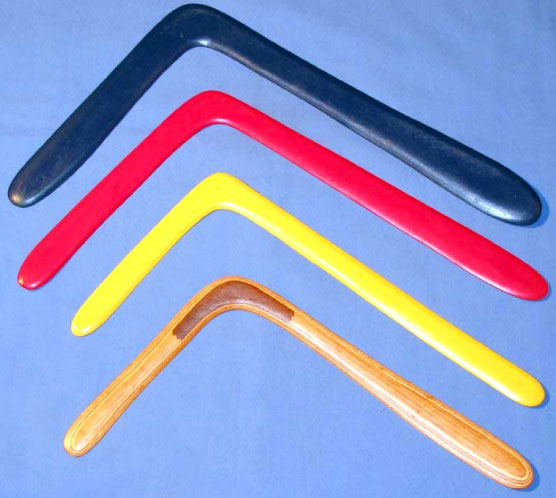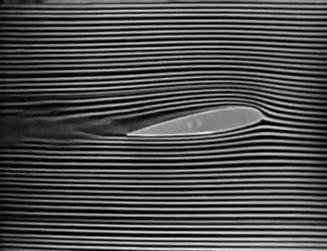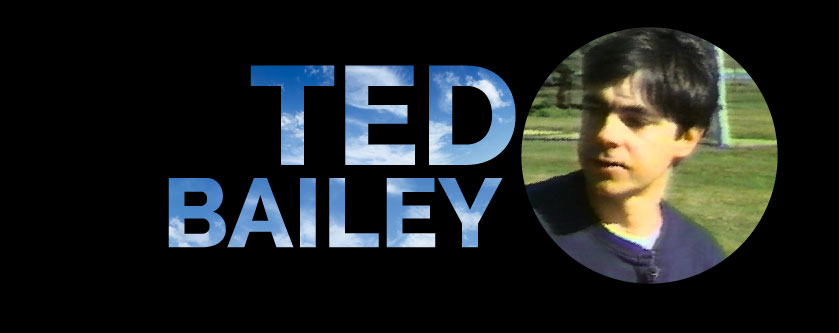1. How did you get involved with boomerangs?
The first time I saw a boomerang in flight was in Panama when I was 7 years old. Older boys had a cross stick that flew really well, but they would not let me throw it. When I was 9 years old (1959), my mother bought me a plastic Wham-O, the clunky one before Lorin Hawes designed the good one based on the M-17. I threw it passionately for about a week until it went through someone’s basement window and the man who lived there chased me away. I did not throw another boomerang until I was 24.
I was an Engineering student in California and I saw a plastic Wham-O on a counter in a sporting goods store. I bought 3 and threw one of them for days until I figured out the problem was that I was left handed and the airfoils were backwards for lefty throwers. I went out and bought a sheet of 1/2 inch Fir plywood and made a mirror image of the Wham-O with some airfoil modifications and it was a fantastic flyer. That hooked me for life. I started making them for friends and selling them on campus to make money to live on while I obtained my University degrees.
2.Which was your aerodynamic approach to design MTAS back in the day?
In the early days, I thought that the secret to a long flight was having a powerful throw. My longest flight times were with a Gerhards S/L hook at about 16 seconds. In the late 1970s and early 1980s, I lived in Florida and I spent more time surfing than throwing boomerangs. In 1982, I moved to Toledo, Ohio and went to my first tournament in Delaware, Ohio. I read an article in the BBS Bulletin that was written by Wilhelm Bretfeld, but I didn’t try making any MTAs. In 1983, Barnaby Ruhe went to England and brought back some MTAs made by David Schummy. Ben Ruhe sent me tracings of these and encouraged me to try designing one on my own. In 1984, I went to the second USA/Aussie Challenge Match in Delaware Ohio and saw Peter Ruhf throwing an MTA that had flights of 20-30 seconds in windy conditions.
It was a very large MTA that resembled the Bretfeld/Shummy designs and as soon as Peter caught his MTA, he would put it into a large sock so that no one else could see what he was using. That hooked me and I decided to use my Aerospace Engineering skills to design the best MTA possible. Between August 1984 and November 1984, I bought several sheets of different thickness plywoods and I ordered several Aerodynamic papers and books from NASA and AIAA. I also noticed that Maple seed samaras were small, but they flew for a very long duration. Check this article about flying seeds

I ordered more papers about Samara Aerodynamics. I had about 100 boomerangs in my collection at this time and spent one weekend throwing everything to see what had the best spin rate to use on a MTA. The best model was a Bob Burwell Rippah with straight arms and a 100 degree angle between the blades. I made copies of the Rippah and extended the lift arm to give me the same arm length ratio as the Bretfeld models. I tried making large and small MTAs, but nothing was a great flyer. The next breakthrough was when I spent a weekend with Al Gerhards. He had an experimental hook design that flew high and hovered. This was not a good trait for a Gerhards hook. Al showed me how he bent the blades down and added angle of attack to make it fly like the other hooks. That gave me a breakthrough in the design.
Until then, I did not realize how important tuning was to the performance. I went home and started doing the opposite of what Al had done to his odd hook. I wanted my MTA to fly like Al’s strange hook, high with hover. I also figured out that you needed to align the surface grain to be parallel to the lift am. From the NASA books, I learned that a parabolic wingtip provided stable flights without the introduction of tip vortices. From the AIAA papers, I learned how the Maple seed Samaras were tuned and where the center of lift was in relation to the lift arm. The beauty of being an Engineer was that I could take all the great work done by others and combine that into a fantastic flying MTA boomerang.
A lot of people try to give me credit for inventing the MTA. i was the first to consistently produce MTAs that flew for minutes or were lost to the jet stream god. However, I only combined the technology of (1) Wilhelm Bretfeld for his arm length ratio, (2) Bob Burwell for his Rippah design, (3) Al Gerhards for his knowledge of tuning, (4) Mother Nature for the evolution of the Maple Seed Samara and (5) NASA and AIAA for all the beautiful mathematical equations that let me put all of this together. The first MTA flight of more than 1 minute was made in April 1985 and within weeks, I was throwing and catching them for 2-3 minutes and losing them to the Jet Stream God. all of these MTAs were very large, like the Bretfeld/Schummy/Ruhf designs.
In Engineering, there is a tool called Buckingham Pi that allows you to scale items and make them smaller or larger with no change in performance. I used this mathematical tool to scale down the MTA and make them much small. By the summer of 1985, I had a MAxi-MTA, Midi-MTA and Mini-MTA and all were wonderful flyers. I also shared my designs in the USBA publication MHR and with other designers around the world.

One of the Mini-MTA models I made was called the Wind Sailor because it was too easy to loose one of these to the Jet Stream God. Jonas Romblad sent me a nice letter with a couple of lap joint MTAs asking if he could use the Wind Sailor design for his composite MTA. that was the end of my involvement in the technological development of the MTA. After that, designs did not change much and the emphasis was placed on manufacturing techniques. I also want to give Rod Jones credit for independently developing a Mini-MTA design that he made by laminating veneers in a spherical dish. This is something that Al Gerhards did with his hooks, but I never did this with my MTAs. As you can see, I played a very important role in the development of the MTA that we know today,, but there were many others who made contributions.
3. Tell us about your famous MTA designs, experiences,models, Great flights, anecdotes.
My best models were mass marketed at low cost so that everyone could experience the magic of MTA. I did not keep my best models in a sock to hide the design. I had many fun experiences with MTAs in the early days.
In 1985, I went to Cleveland to throw with Gary Broadbent. It was frigid cold with ice on Lake Eire and the winds were blowing hard. A Snow Devil (like a small tornado) came by and caught my MTA and Gary’s MTA. You could see the powdery snow on the periphery of the Snow Devil and the MTAs were orbiting around the center like planets around a sun. This lasted for minutes as the Snow Devil headed for Lake Eire. When it hit the lake, the Snow Devil dissipated and both MTAs came down. Gary’s was lost in Lake Eire and mine came down on the shore.
In 1986, there was a debate going around about whether it was possible to do Super Catch. Most throwers said it couldn’t be done. I had MTAs that flew 40+ seconds in calm and I could do 25- seconds in Fast Catch. so I went down to the field and did it. No one believed me. A few weeks later, I had a friend videotape me doing it and I sent the video to Ben Ruhe. The debate over Super Catch was over. The last time I did Super Catch was on my 60th birthday. I haven’t tried it since, but there are a lot of throwers who do it solo. Forget about that team event called Super Catch. That doesn’t count.
4.You are an aerodynamics specialist, how did this help you design your MTAS?
There are lots of subtle tricks that made my MTAs fly better than other maker’s MTAs. If you take the portion of the blade from the widest point to the tip, I made mine with a parabolic curvature. This makes the lift force a constant at the tip, eliminating destructive vortices. I always wet the underside my MTAs to raise the grain and gave it a single coat of Polyurethane. That made the lower surface rough. On the upper surface, I gave it two coats and polished the surface with steel wool to make it smooth. The Reynolds Number ( Re ) is higher on the upper surface because the path length is longer. By making the lower surface rougher than the upper surface, the air exiting the trailing edges had similar boundary layer thicknesses.
This made the airfoils more efficient and eliminated trailing edge vortices. I also figured out that if you didn’t steel wool or smooth the upper surface at the elbow and on both tips, then the MTA flew better. Not sure why, but it worked. Also, when I applied Polyurethane to the underside of the MTA, I would add very fine sand to the tips to make it rougher for both grip and Aerodynamic performance. I did publish these tricks in MHR, but I don’ think anyone else went through the effort of doing this. Where you add dihedral is also very important. I try to add dihedral and angle of attack as close to the tip as possible. For designs like the Wind Sailor with narrow blades, you have to add more dihedral and do it closer to the elbow.

5. Most memorable MTA flight?
The first flight over 1 minute was incredible. It not only flew for 1 minute and 7 seconds, it was stable and I knew it was repeatable. It was my Kitty Hawk moment.
6. What do you think about composite MTAS?
I personally do not like composite MTAs. I could always go onto a field with a single MTA and adjust the tune continuously for existing wind condition. When composite MTAs came out, everyone got lazy and decided that they needed to buy a lot of composite MTAs and then test them all for different wind conditions and organize them for conditions. Composite MTAs were expensive and you needed a lot of them for competition throwing. Some American throwers had 50 or more composite MTAs at $100+ each and they had to be stored carefully. I needed only a single $15 Birch plywood MTA and I always did as well as those with composites. I know that most throwers today use composite and I am impressed by the technology, but I do prefer the more basic design for my own use.
7. Is there room for improvement in MTA performance-construction?
How do you improve on a MTA boomerang that can be lost to the jet stream god? If you improve on the lift, then only more will be lost. I am impressed with the composite tribladers designs that seem to have more wind resistance than the two bladed designs. If I was still involved with the R&D of the MTA boomerang, I would probably try to make a tunable composite MTA. In the 1970s, Al Gerhards showed me a clever design for a strip laminated model that was too stiff to tune in the field. To do research on tuning, Al cut a slot in both wings near the tips and inserted a bicycle spoke that ran through the blade at an angle and terminated at the tip. The spoke had a small screw head that you could turn and add or reduce tension in the spoke. This would result in changes to both the dihedral and angle of attack on one or both blades. That is how Al learned how to tune. I think that something similar could be done in a composite MTA blade and eliminate the need to carry so many MTAs to a tournament.
8. Surface finish has any impact on lift coefficient? Any experience or experiment related to this issue?
Making the underside rougher than the upper surface kept the boundary layers more equal when the air exits the trailing edges. This eliminates trailing edge vortices and makes for a more stable flight, even if the drag coefficient is increased slightly. I also mentioned how I like to keep the upper surface of the elbow and tips rough and add fine sand to the lower surface of both tips. I am sure there are other things that can be done.
9.Makes sense to compare the aerodynamics of hovering MTA to theaerodynamics of a auto rotating rotor?
I think it makes more sense to compare the aerodynamics of a hovering MTA to that of a Maple Seed Samara. The MTA Boomerangs is much lore like the Samara which has a stable hover because the single blade rotates on the surface of an imaginary cone and that gives it stability. When I developed the first high performance MTA Boomerang, I adjusted the length of the dingle arm so that the center of mass of the MTA was identical to that of the Maple Seed Samara and then the added tuning gave it the same rotation about an imaginary cone.
In reality, when you throw an MTA Boomerang and it is traveling fast and climbing high, it is a two bladed boomerang. When it rests in it’s hovering position, it is a single bladed boomerang with the short dingle arm pointed directly into the direction of rotation. It becomes the seed of the Samara. There is a reason why most of natures flying seeds have only a single blade.
10. Have you ever experienced with turbulators on MTAS? any outcome?
No, I can get almost any effect by twisting or bending the airfoils. I tried flaps in the early days. Sometimes in windy conditions, I would use a flap made out of tape to slow the rotation rate down. there is one feature that I used on all of my MTAs that could be called a turbulator. The leading edges of both blades were a sharp 45 degree chamfer (not rounded) and the MTAs made noise when thrown hard. This is turbulation. I always rounded the edges of the elbow and tips, but not the straight wing leading edges.
11. Any advice for boomerang begginers? in terms of tuning.
Yes, learn how to tune. Take a cheap boomerang out to the field and make minor adjustments to angle of attack and dihedral on both blades.
Take notes and remove each tune before proceeding to the next experimental twist or bend. Because of my experiences with MTAs and other booms, I can twist almost anything and make it fly, even a blank without airfoils. Science is fun and knowledge is something that you should learn experimentally. The new world with everything automated scares me. I worry that people will loose the ability to think in the centuries to come.

